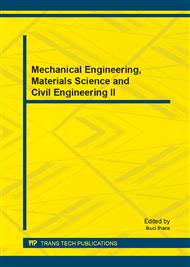p.232
p.236
p.240
p.244
p.250
p.255
p.259
p.263
p.267
Analysis of Removal Rate by Using Magnetorheological Finishing Based on Hysteresis Shear Stress Model
Abstract:
Under the effect of magnetic field, the removing material will produce by using magnetorheo1ogica1 fluid with contains hard magnetic particles or polishing powder, when the magnetorheo1ogica1 fluid moving relative to the workpiece. Magnetorheological finishing is a promising technology for manufacturing super-smooth components surface. According to Preston equation, mathematics model of magnetorheo1ogica1 fluid is established with the hysteresis shear stress model which composed of viscous and bilinear hysteresis shear stress model. After discussing the relationship between magnetic field and material removal studied, the results show that hysteresis shear stress model can describe the mechanical behavior of magnetorheo1ogica1 fluid perfectly and it is simple in form, explicit and easy to apply. Calculated value is consistent with the experimental values and the mathematical model is thus capable to play a guiding role in processing.
Info:
Periodical:
Pages:
250-254
Citation:
Online since:
December 2013
Authors:
Price:
Сopyright:
© 2014 Trans Tech Publications Ltd. All Rights Reserved
Share:
Citation:


